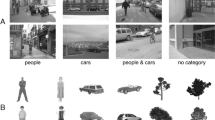Abstract
A common assumption in visual attention is based on the rationale of “limited capacity of information processing”. From this view point there is little consideration of how different information channels or modules are cooperating because cells in processing stages are forced to compete for the limited resource. To examine the mechanism behind the cooperative behavior of information channels, a computational model of selective attention is implemented based on two hypotheses. Unlike the traditional view of visual attention, the cooperative behavior is assumed to be a dynamic integration process between the bottom-up and top-down information. Furthermore, top-down information is assumed to provide a contextual cue during selection process and to guide the attentional allocation among many bottom-up candidates. The result from a series of simulation with still and video images showed some interesting properties that could not be explained by the competitive aspect of selective attention alone.
Similar content being viewed by others
References
Humphreys G W, Bruce V. Visual Cognition: Computational, Experimental and Neuropsychological Perspectives. East Sussex: Lawrence Erlbaum Associates Ltd., UK, 1987.
Pashler H E. The Psychology of Attention. Cambridge, Mass.: MIT Press, 1998.
Broadbent D E. Perception and Communication. London: Pergamon, 1958.
Desimone R, Duncan J. Neural mechanism of selective attention. Annual Review of Neuroscience, 1995, 18: 193–222.
Kastner S, DeWeerd P, Desimone R et al. Mechanisms of directed attention in ventral extrastriate cortex as revealed by functional MRI. Science, 1998, 282(5386): 108–111.
Itti L, Koch C, Niebur E. A model of saliency-based visual attention for rapid scene analysis. IEEE Trans. Pattern Analysis and Machine Intelligence, 1998, 20(11): 1254–1259.
Itti L, Koch C. A saliency-based search mechanism for overt and covert shifts of visual attention. Vision Research, 2000, 40(10–12): 1489–1506.
Sun Y, Fisher R. Hierarchical selectivity for object-based visual attention. In Proc. 2nd Workshop on Biologically Motivated Computer Vision (BMCV'02), Tuebingen, Germany, 2002, pp.427–438.
Deco G, Schurmann B. A hierarchical neural system with attentional top-down enhancement of the spatial resolution for object recognition. Vision Research, 2000, 40(20): 2845–2859.
Carota L, Indiverib A G, Dantec V. A software-hardware selective attention system. Neurocomputing, 2004, 58–60: 647–653.
Standage D I, Trappenberg T P, Klein R M. Modelling divided visual attention with a winner-take-all network. Neural Networks, 2005, 18(5/6): 620–627.
Wolfe J M, Gancarz G. Guided Search 3.0: A Model of Visual Search Catches Up with Jay Enoch 40 Years Later. Basic and Clinical Applications of Vision Science, Lakshminarayanan V (ed.), Dordrecht: Kluwer Academic Press, Netherlands, 1996, pp.1989–1992.
Sun Y, Fisher R. Object-based visual attention for computer vision. Artificial Intelligence, 2003, 146(1): 77–123.
Rainer G, Assad W F, Miller E K. Selective representation of relevant information by neurons in the primate prefrontal cortex. Nature, 1999, 393: 577–579.
Spratling M W. Cortical region interactions and the functional role of apical dendrites. Behavioral and Cognitive Neuroscience Reviews, 2002, 1(3): 219–228.
Treue S, Martinez-Trujillo J C. Feature-based attention influences motion processing gain in macaque visual cortex. Nature, 1999, (6736): 575–579.
Reynolds J H, Pasternak T, Desimone R. Attention increases sensitivity of v4 neurons. Neuron, 2000, 26(3): 703–714.
Posner M I. Orienting of attention. Quarterly Journal of Experimental Psychology, 1980, 32: 3–25.
Posner M I, Snyder C R R, Davidson B J. Attention and the detection of signals. Journal of Experimental Psychology: General, 1980, 109: 160–174.
Lee KW, Feng J, Buxton H. Selective attention for cue-guided search using a spiking network. In Proc. International Workshop on Attention and Performance in Computer Vision (WAPCV'03), Graz, Austria, 2003, pp.27–33.
Lee KW. Computational model of selective attention: Integrative approach [Dissertation]. University of Sussex, 2004.
Lee KW, Feng J, Buxton H. Cue-guided search: A computational model of selective attention. IEEE Transactions on Neural Networks, 2005, 16(4): 910–924.
Koch C. Biophysics of Computation: Information Processing in Single Neurons. New York: Oxford University Press, 1999.
Vezhnevets V, Sazonov V, Andreeva A. A survey on pixel-based skin color detection techniques. In Proc. Graphicon-2003, Moscow, Russia, 2003, pp.85–92.
Govindaraju V. Locating human faces in photographs. International Journal of Computer Vision, 1996, 19(2): 129–146.
Reisfeld D, Wolfson H, Yeshurun Y. Context free attentional operator: The generalized symmetry transform. International Journal of Computer Vision, 1995, 14: 119–130.
Kovesi P. Symmetry and asymmetry from local phase. In Proc. Tenth Australian Joint Conference on Artificial Intelligence (AI'97), Perth, Australia, 1997, pp.185–190.
Kim H-S, Kang W-S, Shin J-I, Park S-H. Face detection using template matching and ellipse fitting. IEICE Transaction on Information and System, 2000, E38-D(11): 2008–2011.
Sirohey S A. Human face segmentation and identification. Technical Report CS-TR-3176, University of Maryland, 1993.
Borovicka J. Circle detection using hough transforms documentation. http://linux.fj.cvut.cz/∼pinus/bristol/imageproc/hw1/report.pdf, 2003.
Author information
Authors and Affiliations
Corresponding author
Rights and permissions
About this article
Cite this article
Lee, K. Guiding Attention by Cooperative Cues. J. Comput. Sci. Technol. 23, 874–884 (2008). https://doi.org/10.1007/s11390-008-9171-6
Received:
Revised:
Published:
Issue Date:
DOI: https://doi.org/10.1007/s11390-008-9171-6




